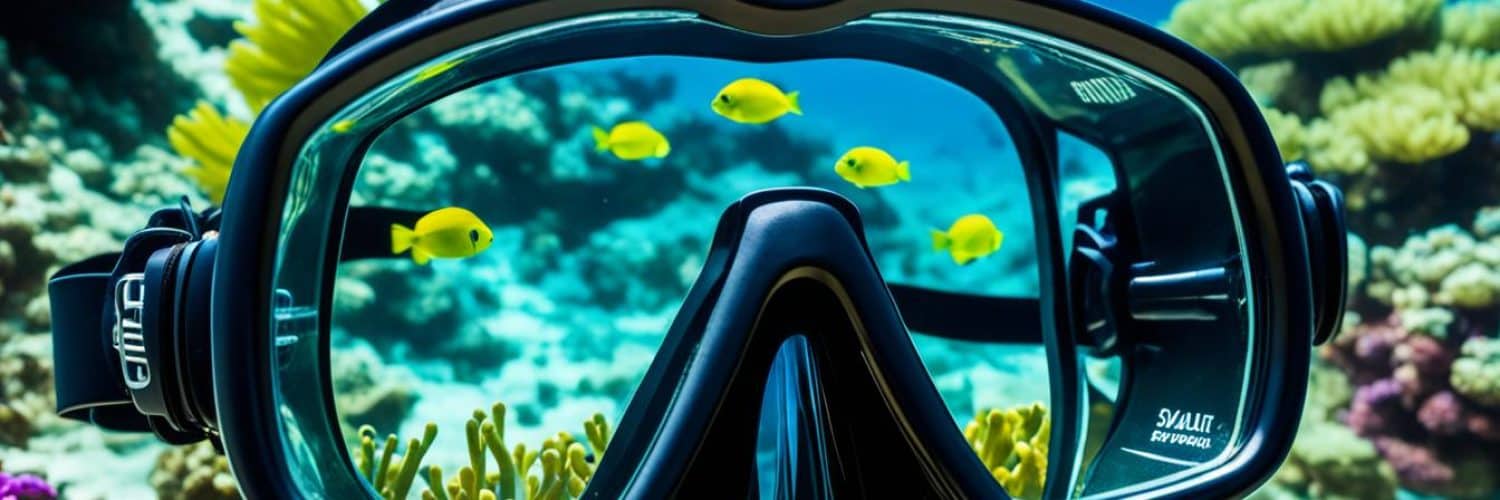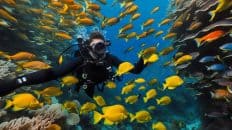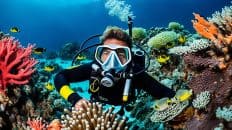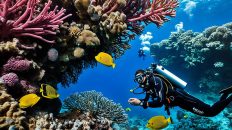Scuba diving goggles are an essential piece of gear for any underwater adventurer. They provide clear vision underwater and enhance the overall diving experience. When choosing the best scuba diving goggles, it’s important to consider factors such as durability, adjustment straps, volume, and the number of windows or lenses. In this article, we will explore the top-rated scuba diving goggles available on the market.
Key Takeaways:
- Scuba diving goggles are essential for clear vision underwater.
- Consider factors like durability, adjustment straps, volume, and number of windows when choosing scuba diving goggles.
- Research and choose from the top-rated scuba diving goggles available on the market.
- Ensure your scuba diving goggles provide a comfortable and secure fit.
- Invest in scuba diving goggles that enhance your underwater adventures.
Durable Materials and Design Features of Scuba Diving Masks
When it comes to scuba diving gear, the importance of a high-quality scuba diving mask cannot be understated. These masks are not only designed to provide clear vision underwater but also to withstand the harsh conditions of the deep sea. Let’s take a closer look at the durable materials and design features that make scuba diving masks essential equipment for underwater exploration.
Scuba diving masks are crafted from durable materials to ensure longevity and reliability. One key component is the tempered glass windows, which are designed to offer exceptional clarity and resistance to scratches. Unlike regular glass, tempered glass can withstand the pressure of the water column without cracking or shattering, providing divers with a protected and unobstructed view of the underwater world.
The skirt of a scuba diving mask also plays a crucial role in its durability and performance. The skirt is the part of the mask that creates a seal against the face, preventing water from entering. Most masks feature a skirt made from soft silicone, which not only provides a comfortable fit but also enhances the mask’s durability. Silicone is known for its flexibility, resistance to degradation, and ability to maintain a watertight seal, making it an ideal material for scuba diving masks.
In addition to the durable materials used, scuba diving masks are designed with features that ensure a secure and comfortable fit. The masks typically have a double silicone seal around the top of the mask, creating a cushioned barrier that molds to the diver’s face. This double seal not only prevents leaks but also enhances comfort during long dives. Moreover, scuba masks have a single silicone seal at the bottom, allowing divers to easily clear any water that may enter the mask.
Another design feature of scuba diving masks is the adjustable straps on either side. These straps enable divers to achieve a personalized fit by easily adjusting the tension of the strap. This ensures that the mask stays securely in place and minimizes the risk of water leakage, even during vigorous underwater activities.
With their durable materials and thoughtful design features, scuba diving masks provide divers with the confidence and comfort they need to explore the underwater world. Whether you are a beginner or an experienced diver, investing in a high-quality mask is essential for a safe and enjoyable diving experience.
Volume and Field of Vision in Scuba Diving Masks
When it comes to scuba diving masks, two important factors to consider are volume and field of vision. The volume of a scuba diving mask refers to the amount of air space inside the mask. Low-volume masks, which sit closer to the diver’s face, are preferred as they provide several advantages.
Firstly, low-volume masks are easier to clear, allowing divers to quickly expel any water that may enter the mask. This feature ensures that the diver’s vision remains clear throughout the dive, improving safety and comfort. Moreover, low-volume masks offer a wider field of vision, providing a more natural and wide-angle view underwater.
Aside from volume, scuba masks also come with one-window or two-window designs. One-window masks provide a more uninterrupted field of vision, allowing divers to fully immerse themselves in the underwater environment. On the other hand, two-window masks may offer a wider peripheral view, enabling divers to see their surroundings more effectively.
Ultimately, the choice between low-volume masks and one-window or two-window designs depends on personal preference and diving style. Whether you prioritize a wider field of vision or a more compact mask, there are options available to suit your needs.
Enhance your diving experience with dive goggles that offer optimal volume and an expansive field of vision. Remember, clear vision is key to exploring the mesmerizing underwater world.
Comparison of Volume and Field of Vision in Scuba Diving Masks
| Mask Type | Volume | Field of Vision |
|---|---|---|
| Low-volume mask | Less air space | Wider, natural view |
| High-volume mask | More air space | Restricted, narrower view |
| One-window mask | N/A | Uninterrupted view |
| Two-window mask | N/A | Wider peripheral view |
Framed vs. Frameless Scuba Diving Masks: A Comparison
When it comes to choosing a scuba diving mask, one important decision to make is whether to go for a framed or frameless design. Both options have their advantages and it ultimately comes down to personal preference and the benefits that each type offers.
Framed Scuba Diving Masks
Framed masks are characterized by a visible plastic frame that holds the lenses and skirt together. This design provides stability and structure to the mask, making it a popular choice among divers. The frame ensures that the lenses are securely held in place, reducing the risk of leakage or displacement during underwater exploration.
Advantages of Framed Scuba Diving Masks:
- Stability and durability
- Securely holds lenses in place
- Provides a reliable seal against water ingress
Many divers appreciate the robustness of framed masks, especially in challenging diving conditions. The plastic frame also allows for easy replacement of lenses if needed, providing flexibility and convenience to users.
Frameless Scuba Diving Masks
Frameless masks offer a sleek and minimalist design, with a less visible or prominent frame. In this design, the skirt of the mask is molded directly into the front, creating a seamless and lightweight construction.
Advantages of Frameless Scuba Diving Masks:
- Lightweight and compact
- Wider field of view
- Less drag in the water
Frameless masks are favored by divers who prioritize comfort and ease of use. The absence of a visible frame allows for a wider field of view, enhancing the diver’s peripheral vision and overall underwater experience. Additionally, the compact and streamlined design reduces drag, making it ideal for long dives or snorkeling activities.
Choosing between framed and frameless scuba diving masks depends on factors such as personal preference, diving style, and individual needs. Take into consideration the level of comfort, field of view, and overall fit when making your decision. Whether you opt for the stability of a framed mask or the lightweight design of a frameless mask, both options can provide a clear and enjoyable diving experience.
Silicone Skirt Color and Fit of Scuba Diving Masks
Scuba diving masks are an essential part of your scuba diving gear, providing a clear and comfortable view of the underwater world. One important component of a scuba diving mask is the silicone skirt that seals against the face. The silicone skirt comes in different colors, including black, clear, and brightly colored options. While the choice of silicone skirt color is mainly an aesthetic preference, it’s worth considering the pros and cons of each.
Black silicone: Masks with a black silicone skirt offer a sleek and professional look. They also have the advantage of reducing reflections, providing a clearer view and minimizing distractions underwater.
Clear silicone: Masks with a clear silicone skirt give a more open and spacious feel, allowing more light to enter the mask. However, clear silicone skirts are prone to discoloration over time, so regular cleaning is essential to maintain their transparency.
Brightly colored silicone: Some divers prefer masks with brightly colored silicone skirts for a fun and personalized look underwater. These masks can be easily spotted and identified, making them a popular choice for group diving or underwater photography.
Aside from the silicone skirt color, it’s crucial to ensure the mask fits properly on your face. A well-fitting mask should create a secure seal without any leaks or discomfort. Some divers may have narrower or smaller faces, requiring masks specifically designed to accommodate their facial structure. Additionally, there are masks designed for children, ensuring a comfortable and snug fit for young divers.
Remember, choosing a scuba diving mask with the right silicone skirt color and fit enhances your diving experience, allowing you to explore the underwater world with confidence and clarity.
Note: The image above showcases a diver wearing a scuba diving mask, highlighting the importance of a proper fit and silicone skirt color. The image is for illustrative purposes only and does not represent any specific brand or product.
Fog-Free and Prescription Scuba Diving Masks
While manufacturers may claim that certain masks are fog-free, it is important to properly clean and treat new masks before use to prevent fogging. Some divers use toothpaste or lighter heat to remove the film from the inside of the glass.
Prescription scuba diving masks are available for divers who require optical corrective lenses. These masks allow for a clear underwater experience for individuals with myopia or other vision impairments.
| Advantages of Fog-Free Scuba Diving Masks | Benefits of Prescription Scuba Diving Masks |
|---|---|
|
|
Divers who wear glasses or contact lenses can benefit greatly from prescription scuba diving masks. These masks offer a convenient solution, eliminating the need to wear bulky glasses or uncomfortable contact lenses underwater.
It’s important to note that prescription scuba diving masks are custom-made to fit individual vision requirements. Divers who require prescription lenses should consult with their optometrist or dive shop to order a mask with the correct prescription.
Fog-Free Techniques for Scuba Diving Masks
Using toothpaste or lighter heat can effectively remove the film from the inside of the glass in scuba diving masks, reducing the chances of fogging during dives.
Here are two popular methods for achieving fog-free scuba diving masks:
- Toothpaste method: Apply a small amount of non-abrasive toothpaste to the inside of the mask’s lens. Rub the toothpaste in a circular motion, covering all areas of the lens. Rinse the mask with fresh water, ensuring all toothpaste residue is removed. This method removes the film and creates a fog-resistant surface.
- Lighter heat method: Carefully pass a lighter flame over the inside of the mask’s lens for a few seconds, ensuring not to overheat or damage the mask. Allow the lens to cool and rinse with fresh water. This method burns off the film and creates a fog-resistant surface.
It’s essential to follow the manufacturer’s instructions and recommendations when treating scuba diving masks for fog prevention. Additionally, always perform a proper rinse with fresh water after using these techniques to remove any remaining residue.
Full-Face Masks for Scuba Diving: Advantages and Considerations
Full-face masks are gaining popularity in the recreational diving scene, although they were originally used primarily by commercial divers and special forces. These masks offer several advantages over traditional scuba diving masks, including the ability to communicate underwater and the option to equip them with a surface support person. Full-face masks cover the entire face, providing a more comprehensive and immersive experience while diving.
One of the main advantages of full-face masks is communication. With a built-in communication system, divers can easily communicate with their dive buddy or the surface support person without the need for hand signals or writing on slate. This makes diving safer and more efficient when diving in a team or conducting underwater tasks that require constant communication.
Another benefit of full-face masks is the option to equip them with a surface support person, particularly useful for novice divers or those who may have concerns about diving alone. The surface support person, often located on a boat or nearby platform, can monitor the diver’s progress, provide guidance, and assist in emergency situations. This added layer of support can provide peace of mind and enhance safety during the dive.
Despite the advantages, full-face masks come with certain considerations and may not be suitable for all divers. It is important to receive proper training on how to use and maintain these masks to ensure safe usage. Full-face masks require specific techniques for clearing water from the mask, equalizing pressure, and emergency procedures. Divers should also be aware of potential limitations, such as restricted peripheral vision and the need for proper fit and adjustment.
Proper maintenance of full-face masks is crucial to their effectiveness and longevity. Regular cleaning and inspection of the mask’s components, such as the silicone skirt, straps, and valves, are necessary to ensure they are in good working condition. Divers should follow manufacturer guidelines and recommendations for maintenance and storage to prevent damage and ensure optimal performance.
Advantages of Full-Face Masks:
- Communication underwater
- Option to equip with a surface support person
- Comprehensive and immersive experience
Considerations for Full-Face Masks:
- Proper training and maintenance required
- Restricted peripheral vision
- Need for proper fit and adjustment
Overall, full-face masks offer unique advantages and considerations for scuba diving. They can enhance communication, provide an immersive experience, and offer the option for surface support. However, divers should receive proper training, be aware of limitations, and ensure regular maintenance for safe and effective usage.
Review of Top Scuba Diving Masks
When it comes to scuba diving, having the right mask can make all the difference in your underwater adventures. With numerous options on the market, it can be overwhelming to choose the best scuba diving mask that meets your specific needs. To help you make an informed decision, we have reviewed and tested some of the top-rated scuba diving masks available.
Factors Considered in the Evaluation Process
Our evaluation process took into account several key factors that are crucial for an exceptional scuba diving mask:
- Fit: We assessed how well the mask fits different face shapes and sizes to ensure a comfortable and secure fit.
- Comfort: Comfort is essential during long dives, so we examined the overall comfort of each mask, including the skirt, strap, and weight distribution.
- Durability: Scuba diving masks need to withstand the rigors of underwater environments, so we tested their durability and resistance to wear and tear.
- Lens Type: We considered masks with various lens types, such as single window, double window, or panoramic, to cater to different preferences and needs.
- Ease of Adjustment: Adjustable straps and buckles are important for achieving a customized and secure fit, so we evaluated how easy it was to make adjustments underwater.
Keeping these factors in mind, we have compiled a list of the best scuba diving masks currently available. These masks have not only scored high in our evaluations but have also received rave reviews from satisfied customers.
Without further ado, here are our top picks for scuba diving masks:
Top Scuba Diving Masks
| Mask | Features | Rating |
|---|---|---|
|
4.9/5 | |
|
4.8/5 | |
|
4.7/5 |
These scuba diving masks have consistently ranked at the top due to their outstanding features and reliability. Whether you are a beginner or an experienced diver, you can trust these masks to provide a clear and comfortable vision underwater.
Keep in mind that choosing the best scuba diving mask ultimately depends on your personal preferences and specific diving needs. Consider factors such as fit, comfort, lens type, and additional features when making your final decision.
Conclusion
Scuba diving goggles are an essential piece of equipment for any diver. They play a crucial role in providing clear vision and a comfortable fit, enhancing your overall underwater experience. When selecting the perfect scuba diving goggles, it is important to consider various factors such as materials, volume, field of vision, and design.
Whether you prefer a framed or frameless mask, one window or two, there are numerous options available to suit your preferences. The right scuba diving goggles will offer you crystal-clear vision and a secure fit, allowing you to fully immerse yourself in the underwater world.
To find the best scuba diving goggles for your needs, take your time to research and explore the available options. Look for high-quality materials that provide durability and a comfortable silicone skirt that seals against your face. Consider the volume of the mask, as a lower volume offers easier clearing and a wider field of vision. Additionally, think about whether a framed or frameless mask would better suit your diving style.
Investing in top-notch scuba diving goggles ensures that you can fully enjoy and appreciate the wonders of the underwater world. So, get ready to embark on your next diving adventure equipped with the best scuba diving gear that meets your requirements and allows you to explore the depths with confidence!
FAQ
What factors should I consider when choosing scuba diving goggles?
When choosing scuba diving goggles, it is important to consider factors such as durability, adjustment straps, volume, and the number of windows or lenses. These factors will determine the overall comfort, fit, and vision provided by the goggles.
What materials are scuba diving masks made from?
Scuba diving masks are crafted from durable materials such as tempered glass windows and a skirt made from soft silicone. The windows are typically made from tempered glass to ensure clarity and resistance to scratches, while the silicone skirt provides a comfortable and secure fit.
What is the volume of a scuba diving mask?
The volume of a scuba diving mask refers to the amount of air space inside the mask. Masks with a lower volume are easier to clear and provide a wider field of vision. Low-volume masks sit closer to the diver’s face and offer a more natural and wide-angle view underwater.
What is the difference between framed and frameless scuba diving masks?
Framed masks have a visible plastic frame that holds the lenses and skirt together, while frameless masks have a less visible or prominent frame, with the skirt molded into the front of the mask. Frameless masks are often preferred for their lighter weight and wider field of view.
What is the purpose of the silicone skirt on a scuba diving mask?
The silicone skirt on a scuba diving mask seals against the face to prevent water from entering the mask. The skirt can be either black, clear, or brightly colored silicone. The choice of silicone skirt color is mainly an aesthetic preference, although clear silicone is prone to discoloration over time.
Are there scuba diving masks available for individuals with prescription goggles?
Yes, prescription scuba diving masks are available for individuals who require optical corrective lenses. These masks allow for a clear underwater experience for individuals with myopia or other vision impairments.
What are the advantages and considerations of using full-face masks for scuba diving?
Full-face masks offer the benefit of communication underwater and can be equipped with a surface support person. However, they require proper training and maintenance to ensure safe usage and may not be suitable for all divers.
What are some top-rated scuba diving masks on the market?
In this article, we provide a detailed review of the top-rated scuba diving masks. These masks have been tested for factors such as fit, comfort, durability, lens type, and ease of adjustment. Customer reviews have also been considered in the evaluation process.
What should I consider when choosing scuba diving goggles for a comfortable fit?
It is important to ensure that the scuba diving goggles fit properly on your face, with no leaks or discomfort. Some divers may require masks specifically designed for narrower or smaller faces, or for children. Taking the time to find the right fit will enhance your underwater adventures.







Add comment